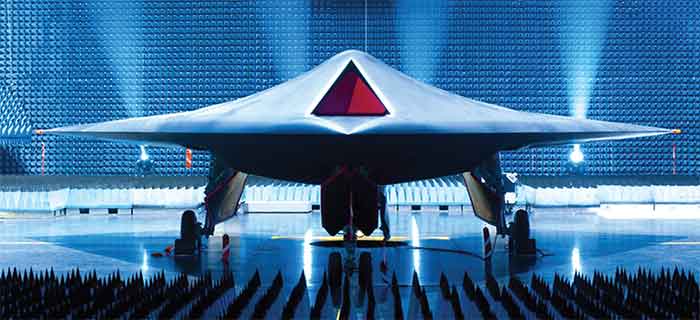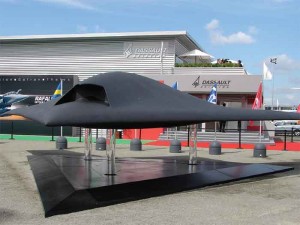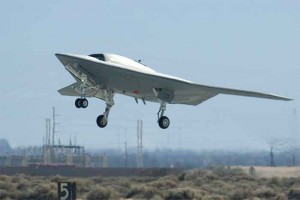Small is Beautiful
Stealth is prohibitively expensive. But with rapid advances in miniaturisation technology any designer can aim for smallness, which also serves to make detection more difficult. For instance, the US Navy and Marine Corps are reportedly on the lookout for a small UAV weighing less than 30 pounds that can fly for eight hours carrying both day and night video cameras. It would represent a significant improvement over devices such as the hand-launched Aerovironment RQ-11B Raven and RQ-20A Puma. A year ago, the US Army also contracted five companies for the production of small UAVs.
UCAVs afford greater range, manoeuvrability and payload capacity than manned strike aircraft…
Israel’s IAI is designing the Butterfly, a super-micro UAV that resembles a toy. The smaller version weighs eight grammes while the bigger one is just 13 grammes. Powered by a lithium-polymer battery, the Butterfly can fly for about 20 minutes. It is very silent and, when it hovers, seems to merge with the background and practically disappear. IAI intends it as a tiny device that can fly through buildings and relay video and sound to ground forces outside. Its utility in an urban warfare setting can only be imagined.
With UAVs becoming smaller and cheaper, large swarms could be launched against a single target so that even if some were destroyed the rest could continue to operate and would overwhelm the enemy’s defences.
Staying Power
One of the key requirements of a UAV designed for ISR is endurance or persistence. While manned aircraft can be refuelled in flight, most UAVs cannot, thus limiting their ability to stay on station. Still, their endurance, earlier measured in hours, is now frequently expressed in days. The AeroVironment Global Observer is a stratospheric persistent UAV designed for defence and homeland security missions. It can carry communications and remote sensing equipment for military or commercial purposes. With a payload of 180 kilogrammes it can operate at altitudes of up to 65,000 feet. It has liquid hydrogen-fuelled propulsion and can remain airborne for seven days. In the not-too-distant future some UAVs, either hydrogen or solar powered, may stay aloft for weeks or even months.
Civilian Surge
Thus far, UAVs have remained largely military and law enforcement devices. However, pressure is mounting from a host of potential civilian users for permission to operate their own drones. The US Federal Aviation Administration (FAA) recently cleared several sites to test civilian UAVs. If all goes well, the FAA expects over 7,500 small unmanned aircraft to swarm US airspace in the next five years. Civilian drones could be used for numerous applications such as remote sensing, prospecting for minerals, mapping natural resources or inhospitable terrain, tracking the progress of wildfires, finding lost people and fighting crime. Amazon.com hopes to use mini-drones to deliver small and urgent packages to customers in just 30 minutes. What next? Drone delivery of pizzas?
One of the key requirements of a UAV designed for ISR is endurance or persistence…
However, apart from strong privacy concerns about anonymous drones clandestinely taking pictures and snooping on citizens, a more practical issue is how to prevent them from colliding with manned aircraft. Flight safety agencies believe that UAVs for civilian use must have on-board “Sense And Avoid” (SAA) systems. To this end, General Atomics Aeronautical Systems is testing a prototype device that allows a UAV to detect nearby aircraft and take action to avoid collisions. Once a reliable SAA system is introduced the FAA would probably permit civilian UAVs to operate in the same airspace as manned aircraft. Currently, they are restricted to limited airspace in which they operate exclusively.
The Age of the Drones
The main attraction of military UAVs stems from the fact that their acquisition and training costs are far lower than those of combat jets. They can also be operated or stored at a fraction of the cost of manned aircraft. Neither do drones risk the life of a pilot nor are they subject to physiological limitations. They can remain airborne for prolonged periods – loitering at great height and striking or assisting strikes with devastating accuracy when an opportunity arises. On these and other counts, they are superior to fixed wing aircraft and cruise missiles. They will surely play a key role in most future conflicts.
However, the remarkable progress in unmanned devices does not signal the demise of manned combat aircraft, just yet. It seems more likely that UAVs will supplement manned aircraft in a growing number of operational situations for many years to come.
As drones proliferate across the globe, ethical and other concerns are growing in tandem. For instance, ties between the US and Pakistan have plunged over US UCAV strikes against targets on Pakistani soil. Apart from these strikes being a breach of its sovereignty, the Pakistani government insists that they mostly kill innocent civilians. The Americans defend the strikes as an indispensable tool used with restraint against deadly militants but critics feel they resemble summary executions, not acts of war.
Independent military experts also warn that what is sauce for the goose is sauce for the gander. Currently, the US is the main operator of lethal UCAVs and its actions go virtually unchallenged. Since America and its allies have set a precedent with clandestine drone strikes over foreign territory, what is to stop enemy states or even non-state actors from launching similar attacks against US interests and then denying involvement?








This piece of writing is really a nice one it helps new internet people, who are wishing for blogging.